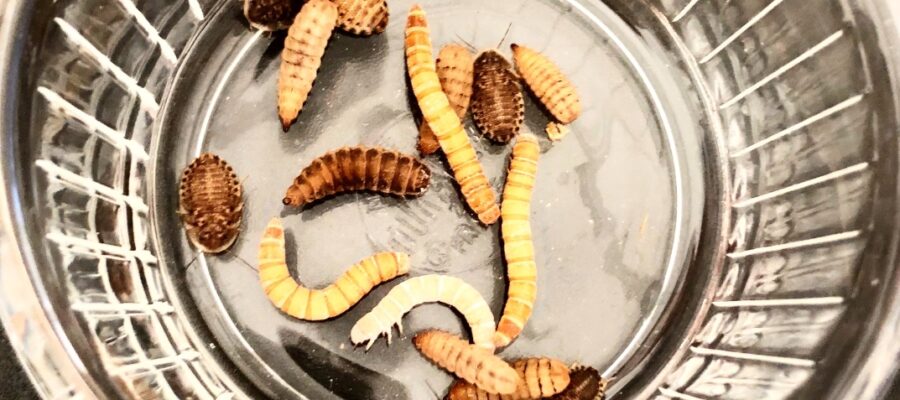On my Instagram page I get quite a few messages asking questions about the insects I use to feed my leopard geckos, so this has prompted me to do a short blog post about my feeding routine.
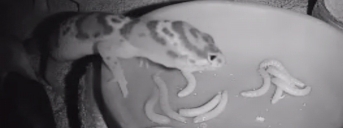 Disclaimer: This is what works for me and my geckos, keeping them healthy and happy – I’m not saying that everybody should do what I do.
Disclaimer: This is what works for me and my geckos, keeping them healthy and happy – I’m not saying that everybody should do what I do.
Over the next month I will follow up this post with several more giving a more detailed overview of the various insects I use. Hopefully you find this helpful 🙂
Q. What do you feed your leopard geckos?
I feed them a mixture of insects; each having its own set of positive attributes and drawbacks. I believe it’s important to feed my leopard geckos as much of a varied diet as I can provide.
Currently my regular feeders are: mealworms, dubia roaches, phoenix worms (aka calci worms), silkworms, locusts, and the occasional waxworm. My leos haven’t had crickets since they were very young – I find them too much of a hassle considering the nutritional content isn’t that great anyway. Also they’re noisy, smelly, and they stress out my geckos who are usually too lazy to catch them… the list goes on. But this is just a personal preference.
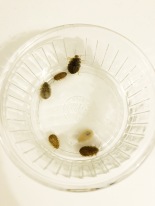
Q. Which is your favourite feeder insect?
I like different insects for different reasons, but I must say that my favourite all-rounder has to be dubia roaches. They are easy to keep and low maintenance, they have a good nutritional value and contain a high moisture content, they move around a lot and my geckos seem to LOVE them, and they have a relatively soft shell so I don’t need to worry about them giving my geckos digestive problems.
Last but certainly not least, they can’t crawl out of smooth surfaces, so I can put them in a dish and forget about them, without worrying they’ll get lost in the vivarium.
Q. …and which is your LEAST favourite?
As mentioned above, I don’t bother with crickets, but aside from that, my least favourite has to be silkworms, mainly because they are expensive and so difficult to look after!
They need to be fed a very specific diet of mulberry leaves or mulberry chow ONLY, they die very easily due to things like too much moisture or germs from your hands, and they don’t move around a lot so they’re less stimulating for my geckos. I don’t always have a supply of silkworms but I will continue to buy them because they have a really good nutritional profile so they’re just about worth the extra effort.
Q. Where do you get your insects from?
I now get all of my insects from eBay. I live in central London and I find this to be the cheapest and most convenient option (I don’t live anywhere near a pet store supplying insects!)
Q. How much do your insects cost?
Dubia Roaches – 50 small roaches – £3.33 + (£4.79 postage)
50 Phoenix Worms (Calci worms) – £6.99 + free postage
50 Silkworms – £5.99 + £3.40 postage
Silkworm Mulberry Chow – £2.50 + £3.40 postage
Mealworms 120g tub – £4.49 + free postage
50 Waxworms – £4.49 + free postage
50 Locusts – £6.99 + free postage
50 Morio Worms – £4.49 + free postage
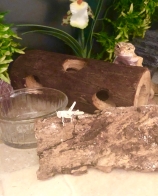 Q. How often do you feed your leopard geckos?
Q. How often do you feed your leopard geckos?
For the first year of their life it was every evening, however if we went away for a night, we would leave extra mealworms or roaches just to sustain them until we are home the next day. Their metabolism has slowed down as they have reached adulthood, and they don’t seem to want to eat every day, so we feed them between 3-4 times a week depending on their mood. See: How often do you need to feed a leopard gecko?
Q. How much do you feed your leopard geckos?
Usually about 7-10 insects per feeding. If they eat all the insects immediately within about 10 minutes, I’ll give them some more, but 8-10 insects seems to be their limit. The amount they eat in each feed is decreasing as they get older.
Q. My leopard gecko won’t eat, what advice do you have?
There could be many reasons so I have written an entire post on the topic 🙂 Please take a look at: Why isn’t my leopard gecko eating?
Q. Do you dust your insects with extra vitamins?
I dust dubia roaches and mealworms with calcium and/or vitamin D3 powder with calcium, but the other insects such as phoenix worms and silkworms have quite a good nutritional profile so you don’t need to. I keep most of my insects gutloaded but not all feeders need gutloading. I always keep a pot of calcium in my geckos’ tanks so they can help themselves to it if they need to.
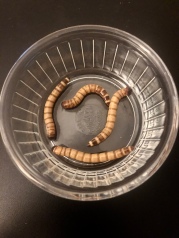 Q. Which feeding dish do you use?
Q. Which feeding dish do you use?
I tend to buy insects which can’t climb smooth surfaces, and I have found that a glass ramekin is absolutely perfect for making sure none of the insects escape! I reviewed some dishes here: Review: Feeding dishes for leopard geckos
Q. Any other advice on feeding leopard geckos?
Yes! Only use waxworms as a treat, or if you’re trying to tame your gecko. I only use waxworms every 1-2 weeks.
Geckos LOVE waxworms – they’re like candy (really tasty but really bad for the gecko and can be addictive!).
So if you feed them their favourite food when you’re handling them, they will come to associate you, and your hand, with being fed their favourite treat. I used food to tame my geckos, and had them tame and crawling onto my hand within a week.
Get Your Free Leopard Gecko Care Checklist!
Are you ready to give your leopard gecko the best care possible? Download our FREE PDF e-book featuring a comprehensive care checklist!
This handy guide covers everything from habitat setup to feeding and health tips, ensuring your gecko thrives.
👉 Download your checklist now!


